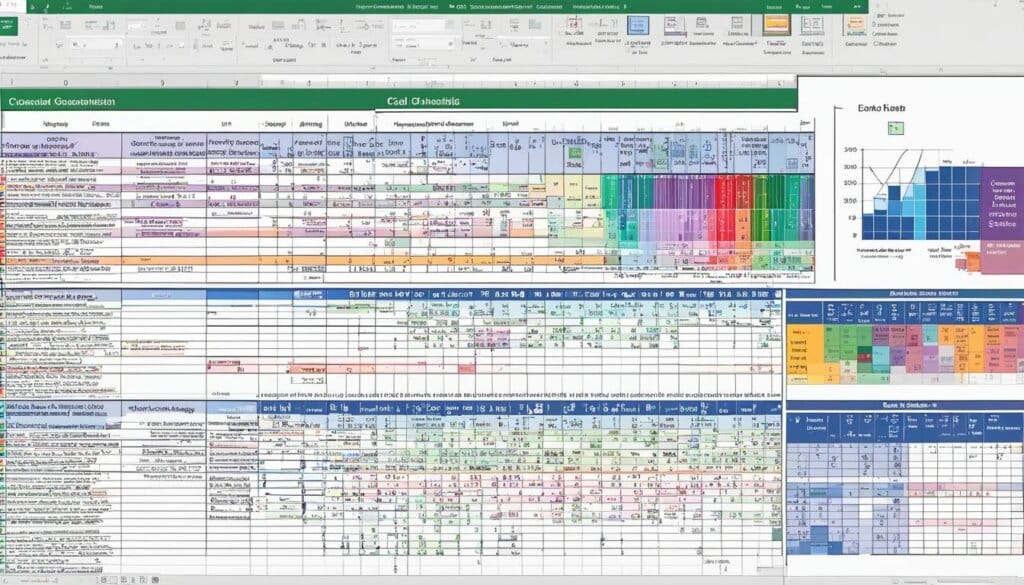Table of Contents
Welcome to our comprehensive guide on Excel, the powerful application that revolutionizes data management and analysis. In today’s data-driven world, Excel has become an indispensable tool for businesses and individuals alike. Whether you’re a student, analyst, or entrepreneur, understanding Excel’s features and functionalities is essential for efficient data management and analysis.
In this guide, we will explore the key aspects of Excel, including data management, data analysis, and the myriad of features that make it one of the most widely used spreadsheet applications. From creating workbooks to performing calculations, from utilizing functions to visualizing data with charts and graphs, Excel offers a wealth of tools to transform raw data into valuable insights.
Whether you’re new to Excel or looking to enhance your existing knowledge, this guide will equip you with the necessary skills to navigate Excel’s interface and leverage its capabilities to their full potential. So, let’s dive into the world of Excel and unlock new possibilities in data management and analysis.
Getting Started with Excel
To begin your journey with Excel, it’s important to understand the basics. This powerful application provides a wide range of functionalities for data management and analysis. Let’s dive into the key steps you need to take to get started.
Creating Workbooks
A workbook in Excel is like a digital notebook where you can store and organize your data. To create a new workbook, follow these simple steps:
- Open Excel by double-clicking on the application icon.
- Click on the File tab in the top-left corner.
- Select “New” from the menu.
- Choose “Blank Workbook” to create a new, empty workbook.
Once you’ve created a workbook, you can start adding sheets or spreadsheets to keep your data organized.
Adding Sheets
Sheets, or spreadsheets, are like individual pages within your workbook. You can have multiple sheets in a workbook to separate your data or create different views. To add a new sheet, follow these steps:
- Click on the plus sign (+) located at the bottom-left corner of the Excel window.
- A new sheet will be added to your workbook.
- You can rename your sheet by double-clicking on the default name (e.g., “Sheet1”) and entering a new name.
Adding sheets helps you keep your data organized and allows for efficient navigation within your workbook.
Entering Data
Now that you have your workbook and sheets set up, it’s time to enter your data. Follow these steps to enter data into cells within your sheets:
- Select the cell where you want to enter your data by clicking on it.
- Type in your data and press Enter to move to the next cell.
- Continue entering data into the desired cells.
Excel allows you to enter various types of data, such as numbers, text, dates, and formulas. Take advantage of this flexibility to input and organize your information accurately.
Applying Formatting
Formatting your data not only improves its visual appeal but also helps in emphasizing important information. Excel provides several formatting options that you can apply to your cells, including:
- Borders: Add borders around cells or ranges to create clear divisions.
- Cell Shading: Change the background color of cells to highlight specific data.
- Number Formats: Format numbers as currency, percentages, or with decimal places.
To apply formatting to your data, follow these steps:
- Select the cell or range of cells you want to format.
- Click on the Home tab in the Excel ribbon.
- Choose the desired formatting option from the toolbar.
Experiment with different formatting options to make your data visually engaging and easier to understand.
Now that you have a grasp of the Excel basics, you’re ready to explore its advanced features and functionalities. In the next sections, we’ll delve into performing calculations, utilizing functions, creating charts and graphs, and more.
Performing Basic Calculations in Excel
Excel is a versatile tool that enables users to perform basic calculations effortlessly. Whether it’s adding up numbers or creating simple formulas, Excel provides several features to streamline these processes.
One of the simplest ways to add numbers in Excel is by using the AutoSum feature. By selecting the cell to the right or below the numbers you want to add and clicking on the AutoSum button, Excel will automatically calculate the sum and display the result. This saves time and reduces the chances of manual calculation errors.
For example, let’s say we have a series of numbers in cells A1 to A5. To calculate their sum, we can follow these steps:
- Select the cell A6, where we want the sum to appear.
- Click on the AutoSum button located in the “Edit” section of the Excel ribbon.
- Excel will automatically select the range of cells above the active cell, in this case, A1 to A5, and display the sum in cell A6.
In addition to AutoSum, users can create simple formulas to perform calculations in Excel. By typing an equal sign followed by a combination of numbers and calculation operators, such as plus (+) or minus (-), Excel will calculate the result.
For example, if we want to calculate the sum of 2 and 4, we can create a formula as follows:
=2+4
This formula will give us the result of 6. Excel can handle more complex calculations using a combination of mathematical functions and operators, allowing users to perform advanced calculations with ease.
With these basic calculation features, Excel empowers users to efficiently perform arithmetic operations, saving time and effort.
https://www.youtube.com/watch?v=rpCaVZCURZQ
Exploring Excel Functions
Excel offers a wide range of functions that can greatly enhance data analysis. Two commonly used functions are VLOOKUP and SUMIF.
The VLOOKUP function allows users to search for a value in the first column of a range and return a corresponding value from a different column, making it useful for data lookup and analysis. This function is particularly handy when dealing with large datasets, as it eliminates the need for manual searching and saves time and effort.
Here’s an example of how the VLOOKUP function works:
=VLOOKUP(lookup_value, table_array, col_index_num, [range_lookup])
| Argument | Description |
|---|---|
| lookup_value | The value to search for in the first column of the range. |
| table_array | The range of cells that contains the data. |
| col_index_num | The column number from which to return the corresponding value. |
| [range_lookup] | Optional. Specifies whether the lookup value should be an exact match or a close match. |
Another useful function is SUMIF, which allows users to sum values based on specific criteria. For example, you can use the SUMIF function to calculate the total sales of a specific product or the total expenses in a month. It provides a convenient way to perform calculations on specific subsets of data.
Below is the syntax of the SUMIF function:
=SUMIF(range, criteria, [sum_range])
| Argument | Description |
|---|---|
| range | The range of cells to evaluate against the criteria. |
| criteria | The criteria or condition to be met. |
| [sum_range] | Optional. The range of cells to sum if the condition is met. If omitted, the range specified in the “range” argument will be used. |
Lastly, the COUNTIF function is another valuable function in Excel that allows users to count the number of cells that meet a certain condition. For instance, you can use the COUNTIF function to count the number of times a specific word appears in a text or the number of sales transactions that exceeded a certain amount.
Here’s the syntax of the COUNTIF function:
=COUNTIF(range, criteria)
| Argument | Description |
|---|---|
| range | The range of cells to evaluate against the criteria. |
| criteria | The criteria or condition to be met. |
These functions are just a few examples of the extensive functions Excel provides for data analysis. By mastering these functions and exploring more advanced ones, you can unlock the full potential of Excel and enhance your data analysis capabilities.

Next, let’s explore the process of creating charts and graphs in Excel to visualize and present your data effectively.
Creating Charts and Graphs in Excel
Excel offers powerful features for creating visually appealing and informative charts and graphs. These visual representations play a crucial role in visualizing data and presenting it in a comprehensible format. With Excel, users can easily select the data they want to include in a chart and choose from a variety of chart types, such as bar charts, line charts, pie charts, and more.
One of the key advantages of using Excel for charting is the ability to customize the appearance of charts. Users can modify colors, fonts, labels, and other visual elements to create visually stunning and impactful charts and graphs.
Charts and graphs are not just visually appealing; they serve a much deeper purpose. They help in visualizing data patterns, identifying trends, and making data-driven decisions. When presented with raw data, it can be overwhelming and challenging to spot patterns or understand the significance. However, with the help of charts and graphs, complex data sets can be simplified and analyzed more effectively.
The Power of Excel Charts
Excel charts enable users to present data in a concise and easily understandable manner. They facilitate the communication of trends, patterns, and relationships within the data, making it easier for both technical and non-technical audiences to grasp the information at a glance.
Charts and graphs are particularly useful when dealing with large datasets or datasets with multiple variables. The visual representation allows for quick comparisons and provides a clear overview of the data’s characteristics. By utilizing different types of charts and graphs, users can highlight specific aspects of their data and emphasize key insights.
“A picture is worth a thousand words.” This popular saying holds true when it comes to data analysis. Charts and graphs not only enhance the visual appeal of data but also facilitate the understanding of complex relationships and trends. They allow users to tell a story with the data, making it easier for others to comprehend and draw meaningful conclusions.
This bar chart clearly represents the sales figures for different products, making it easier to compare their performance. The visual representation allows for a quick understanding of each product’s sales contribution and their relative performance.
Using Excel for Data Analysis and Management
Excel is widely recognized as a powerful tool for Excel data analysis, Excel data management, and data manipulation in Excel. Its extensive range of features and functionalities empowers users to perform complex calculations, apply advanced formulas, and use various functions to analyze and manipulate data effectively.
With Excel, users can efficiently analyze large datasets, identify trends, and make informed decisions based on the data at hand. Its data management capabilities enable users to filter and sort data, create pivot tables, and perform statistical analysis, further enhancing the analytical process.
Moreover, Excel provides the flexibility to perform a multitude of operations on data, enabling users to transform raw information into valuable insights. Whether you need to merge data from different sources, extract specific information, or perform calculations across multiple datasets, Excel’s data manipulation capabilities make it possible.
Let’s explore some of the key features that make Excel an invaluable tool for data analysis and management:
- Powerful Calculations: With Excel, users can perform complex calculations and apply advanced formulas to manipulate and analyze data. Whether it’s performing mathematical operations, aggregating data, or calculating statistical measures, Excel provides a wide array of functions and formulas to cater to different analysis requirements.
- Filtering and Sorting: Excel allows users to filter and sort data based on specific criteria, enabling them to focus on relevant information and identify patterns or outliers easily. This feature is particularly useful when dealing with large datasets or when trying to extract specific subsets of data for analysis.
- Pivot Tables: Pivot tables offer a valuable way to summarize and analyze large sets of data. Users can create dynamic pivot tables in Excel to group and summarize data based on different criteria, providing a clear overview and facilitating deeper analysis.
- Statistical Analysis: Excel provides a range of statistical functions, such as mean, median, standard deviation, and correlation, which allow users to analyze data and draw meaningful conclusions. These functions can be used to perform statistical tests, create charts, and generate insights.
Excel’s capabilities for data analysis and management go beyond the functionalities outlined above. It empowers users to explore and interpret their data effectively, turning raw information into actionable insights. Whether you’re an analyst, a business owner, or an individual looking to gain a deeper understanding of your data, Excel is a trusted tool that can support your endeavors.
Case Study: Analyzing Sales Data
“Using Excel for data analysis has revolutionized our business. With the ability to perform complex calculations, filter and sort data, and create pivot tables, we have gained valuable insights into our sales performance. Excel’s user-friendly interface and powerful features make it a go-to tool for all our data analysis and management needs.” – Sarah Thompson, Sales Manager at ABC Corporation
| Product | Category | Quantity Sold | Revenue |
|---|---|---|---|
| Laptop | Electronics | 250 | $250,000 |
| Smartphone | Electronics | 500 | $100,000 |
| Tablet | Electronics | 150 | $50,000 |
| Watch | Fashion | 300 | $75,000 |
| Shoes | Fashion | 200 | $40,000 |
Saving and Sharing Excel Workbooks
Once you have completed your work in Excel, it is important to save your workbook to preserve your data. Excel allows users to save their work in various formats, including .xlsx, which is the default file format. Saving your workbook ensures that you can easily access and update your data whenever needed.
In addition to saving your workbook, Excel provides options for sharing your files with others. This can be done through various means, such as sending them via email or saving them to cloud storage services like OneDrive. By sharing your workbooks, you can collaborate with multiple users on the same document, making it easier to work together and share data efficiently.
Sharing your Excel files also allows others to review, edit, and provide feedback on your work. This promotes teamwork and enhances productivity, particularly in situations where multiple people need to work on the same set of data. With Excel’s sharing features, you can ensure that everyone has access to the most up-to-date version of the workbook, reducing duplication of effort and improving collaboration.
FAQ
What is Excel?
Excel is a powerful application that allows users to create and manage spreadsheets. It is widely used for data management and analysis purposes.
How do I get started with Excel?
To get started with Excel, you need to create a workbook, which is a document where you can store your data. Within a workbook, you can add multiple sheets to keep your data organized.
How do I perform basic calculations in Excel?
One of the simplest ways to add up numbers in Excel is by using the AutoSum feature. Excel also allows users to create simple formulas by typing an equal sign followed by a combination of numbers and calculation operators.
What are some commonly used functions in Excel?
Two commonly used functions in Excel are VLOOKUP and SUMIF. VLOOKUP allows users to search for a value in the first column of a range and return a corresponding value from a different column. SUMIF allows users to sum values based on specific criteria.
How can I create charts and graphs in Excel?
Excel offers powerful features for creating charts and graphs. Users can select the data they want to include in a chart and choose from various chart types. They can also customize the appearance of the charts by modifying colors, fonts, labels, and other visual elements.
How can I use Excel for data analysis and management?
Excel offers a wide range of features for data analysis and management. Users can perform complex calculations, apply advanced formulas, and use functions to analyze and manipulate data. Excel also provides options for filtering and sorting data, creating pivot tables, and performing statistical analysis.
Once you have completed your work in Excel, you can save your workbook in various formats, including .xlsx. Excel also allows users to share their workbooks via email or by saving them to cloud storage services like OneDrive.












